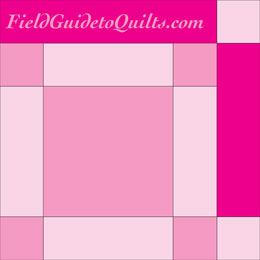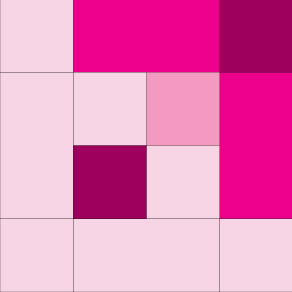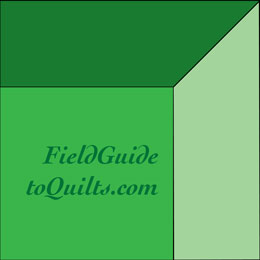| FieldGuidetoQuilts.com |
 Concentric & Offset Squares Concentric & Offset Squares |
Sometimes these strongly diagonal blocks were set on point, which is to say that the lines were perpendicular to the bed. Usually, though, the orientation was on the diagonal — at least, that's how the blocks are.
Picture Frames
 Picture Frames
Picture Frames Picture Frames
Picture FramesKCS, 1951
The Star's instructions say that the stripes should be aligned on each seam.
Mosaic No. 1
















Mosaic, No. 1
 Mosaic No. 1
Mosaic No. 1Ladies Art Company #329, 1897Ladies Art Company block #329 (1897) is a simple, elegant concentric block.
Notice that the light green stripe has mitered corners. It's not like a log cabin, with blunt-ended stripes.
It could easily be made in quarters, using strip piecing, if you're willing to put seams through the center. That way you could use a different fabric for all four of the quarter-squares in the center block.
The LAC used a whole, unpieced center square for this block. That means you'd put the rest of each quarter-block together and attach them one by one to the center square. You'd be using what some call "the dreaded Y seam." But really, it's just a seam, and it's not going to bite you.
Trip Around the World
 Trip Around the World on point
Trip Around the World on point Trip Around the World
Trip Around the World Trip Around the World and Postage Stamp, below, are called one-patch quilts because they're made entirely of one-shape, one-size pieces.
We've seen comments that Trip Around the World is an easy beginner's quilt. Don't believe it. While the quilt is made up of single-sized squares (simple) and lends itself to strip piecing (quick), those corner seams can put up a considerable argument before they line up straight. Don't ask how we know.
Just picture a middle-school class turned loose on a substitute teacher. Got it? Wait till you have some experience before you tackle this one.
When Trip Around the World is turned 45° and edged with triangles, quilters say it's "set on point." Almost always, it's still called Trip Around the World.
"Postage Stamp" quilt
 Postage Stamp Quilt
Postage Stamp QuiltKCS, 1942 Whenever an eBay seller describes a quilt as a "postage stamp" design, it means only that the quilt is a one-patch design made up of small squares, no matter where the colors go.
The "real" postage stamp quilt is this one, from a 1942 Kansas City Star. The name never really caught on, though. The design is almost always called Trip Around the World.
Children's Delight
 Children's Delight
Children's Delight Children's Delight
Children's DelightLAC, #319, 1897
Original
 Children's Delight
Children's DelightLAC #319,1897
With a third color The 1897 block shown at left, the LAC's #319, got its name for no reason we can see.
We've added color to emphasize the effect of the rectangles on the top and right of the block. They produce a windowpane pattern — add sashing, if you prefer to put it that way. You would then add sashing to the bottom and left sides of the whole quilt.
Offset blocks are designed for this purpose. It's a simpler way to introduce sashing than adding it after all the blocks are done.
They're also designed to add perspective, as Shadow Box and New Pattern, below, show so clearly.
Lights & Shadows
















Lights & Shadows
 Lights & Shadows
Lights & ShadowsCabot, 1936A block by Nancy Cabot of the Chicago Tribune. It was published in 1936.
Midget Necktie
 Midget Necktie
Midget Necktie Midget Necktie
Midget NecktieKCS, 1937
The Star published the block in the configuration at left, leaving the placement inscrutable. In our whole-quilt mockup of the block, we've shown one possibility.
Shadow Box
















Shadow Box
 Shadow Box
Shadow BoxMalone, 2003The name is from Maggie Malone's 5,500 Quilt Block Designs (2003), but the block is, in essence, one quarter of Peterson's New Pattern, above.
New Pattern




New Pattern
 New Pattern
New PatternPeterson's Magazine
1857
New Pattern is one of the oldest published block designs. It appeared in an 1857 issue of Peterson's Magazine, a competitor of Godey's Lady's Book. Peterson's outlasted the increasingly fusty Godey's by 20 years.
For perspective, in 1857, Elijah Otis installed his first elevator. The Atlantic published its first issue. The U.S. postal service started using perforated stamps. And the Singer sewing machine company had just invented the first-ever rent-to-own program in its effort to sell machines to families instead of factories.*
Carrie Hall added the name Cross in 1935. *ismacs.net/sewing_machine_articles/martin_gregory_lecture_1996.html. Other events of 1857 can easily be verified on line.



